A must see event! Especially for History 250 students. See linked poster for more details:
When: Mon, 03/21/2011 – 4:10pm – 6:00pm
Where: Hugel 100

A must see event! Especially for History 250 students. See linked poster for more details:
When: Mon, 03/21/2011 – 4:10pm – 6:00pm
Where: Hugel 100
Vietnam veteran and Lafayette alumni Fred Benson ’59 will present a slide show made during a 2010 State Department endorsed trip to Vietnam. Lunch provided. Gendebien Room, 12 noon, Monday March 21st.
http://www.abc.net.au/news/events/japan-quake-2011/beforeafter.htm
http://www.japanquakemap.com/
Dear Lafayette Campus Community:
On March 11, Japan’s northeast coast was devastated by a tsunami accompanied by a series of earthquakes. Over a thousand are presumed dead and many more homeless. Reconstruction and rescue efforts, as well as the work of restoring Japan’s transportation, communication, and power grids, are going to be expensive and difficult. If members of the campus community would like to make contributions to help the Japanese, we know that such generosity would be greatly appreciated.
The Red Cross
the Japan Society
http://www.japansociety.org/news
and NGO-JEN
http://www.jen-npo.org/en/index.html
are all reputable organizations that will deliver aid where it is needed.
Thanks for your time and attention,
The Lafayette College Asian Studies Advisory Committee and Teaching Faculty
Allison Alexy
Paul Barclay
Ingrid Furniss
Naoko Ikegami
Seo-hyun Park
Robin Rinehart
Asma Sayeed
David Stifel
Larry Stockton
Li Yang
To expand our holdings in Japanese-period postcards of colonized East Asia, we have been acquiring various types of images and texts from China’s three northeast provinces, called “Manchukuo” by the Japanese who installed a government there from 1932-1945. The snapshots below were taken by U.S. Vice-Consul Gerald Warner in 1934. The postcards were purchased in Tokyo and Osaka in the summer of 2010. The juxtaposition of snapshot and postcard shows how the commercial imagery of Manchuria predisposed tourists and visiting officials like Warner to see the colony. At the same time, Warner captured images that appear to have been honest attempts to capture something of life in colonized Manchuria beyond that depicted in the familiar genre shots of postcards.
The first card lays bare the power relations that buttressed all of the other scenery presented in Japanese imagery of their frontier empire. It proudly boasts:
“The Kwanto Army Headquarters which is one of our Nippon representatives. The building, somewhere castle-like style, is very imposing and has dignity that anyone can not violate.”
Consul Warner was probably given a tour of the memorialized battlefields of the 1931 conquest. Here is one of his snapshots from the Beidaying barracks, which were emptied of Chinese troops right after the Japanese attack on Shenyang/Mukden on September 18, 1931:
This postcard, issued sometime just prior to Warner’s tour, presents a similar scene with a terse description:
〔奉天 北大営) 第一中隊長小野大尉奮戦の地 機關銃槍連兵舎の一部
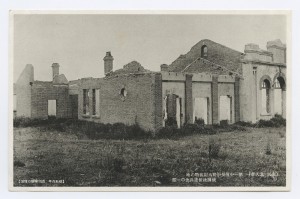 [Trans.:] “The site of 1st Army Commander Captain Ono’s desperate battle. A section of the machine-gun damaged barracks.”
[Trans.:] “The site of 1st Army Commander Captain Ono’s desperate battle. A section of the machine-gun damaged barracks.”
As with other colonies, Japanese postcard producers issued numerous sets of “Customs and Manners” series to depict either the unique folkways of the empire’s many peoples, or perhaps to give a glimpse of the peaceful uninterrupted lives of imperial Japan’s contented subjects.
満州風俗 路傍で公演中の街の手品師
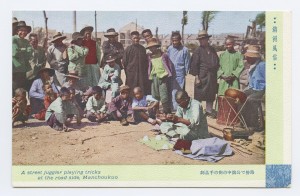 “A street juggler playing tricks at the road side Manchuoukuo”
“A street juggler playing tricks at the road side Manchuoukuo”
Warner’s own snapshot of popular entertainment from the streets of Shenyang:
One of the most common themes of Japanese colonial postcards is that of “old” versus “new.” Below is a government-issue card depicting the modern Japanese constructed port of Dalian in contrast to the traditional donkey and cart form of transportation that prevailed in Northeast China at the time:
Lastly, a snapshot from Consul Warner’s camera showing a street scene in the sleepy border town of Manzhouli, near the Mongolian and Russian borders:
United China Relief Fund
The text on the back of this postcard reads: “This is P’ing Mei–a child of China. He is one of the thirty million children who have been left motherless, fatherless, homeless by four years of merciless war. He is one of 50 million refugees who desperately need food, clothing, shelter, medical aid. He is one of 450,000,000 friendly, democratic Chinese who loved and helped America in the past–who need our help now in order to survive and be a free, independent, friendly neighbor in the future. GIVE TO UNITED CHINA RELIEF, Inc. 1790 BROADWAY NEW YORK, N.Y.”
Soon after this photo was taken, the following description appeared in LIFE magazine: “After 16 Japanese bombing planes had flown home, Aug. 28 H.S. (“Newsreel”) Wong, famous Hearst cameraman, was first to reach the dreadful scene at the Shanghai South Station. He got this picture-of-the-week–a Chinese baby amid the wreckage. A print of it was sent through International News Service to all Hearst newspapers, totaling 1,730,000. (October 4, 1937, p. 102).
Four years later, the same magazine’s editors immortalized Wong’s shot, writing, “in 1937 H.S. (“Newsreel Wong”)…snapped an unforgettable picture of a Chinese baby wailing all alone amidst the desolation of the Shanghai South Station after a Japanese raid. No picture ever aroused more worldwide sympathy for the victims of aggression than did Wong’s.” (March 23, 1942, p.34).
There is much controversy surrounding this famous photograph. The debates center around the degree to which the photograph was staged and the impact of Wong’s anti-fascist sympathies upon the staging of the photograph. This postcard does not provide evidence that Wong’s photo is a “fake,” but does attest to its propaganda value.
Assassination of Zhang Zuolin
This Japanese postcard, published in the early 1930s, eerily commemorates the 4 June 1928 explosion on the South Manchuria Railway that killed regional governor (“warlord”) Zhang Zuolin. The bombing was blamed on Chinese Nationalist (KMT) officers, but it was soon discovered that Japanese staff officers of the Kwangtung Army engineered the assassination. Various efforts to cover-up the incident and protect the malefactors led to the resignation of the Tanaka cabinet in July 1929. According to the markings on the back of the card, the stock upon which the image was printed should predate February 15, 1933. Assuming the normal method of picture-postcard dating applies, this card was published during a period of political chaos in Japan, during the period of “government by assassination.” This card may indicate that assassination, as one of many techniques available to those who would see regime change, had become acceptable even at the level of the postcard-buying public.
For more imagery from the Japanese empires, see:
http://digital.lafayette.edu/collections/eastasia
Back to the Twin Cities for the first visit since graduation in 1999 to participate in academic workshop. University of Minnesota 8/20-24/2010.
Here’s the link:
http://www.ias.umn.edu/Initiatives/BorderlandsConference.php
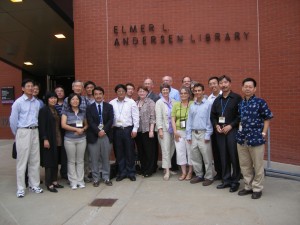 Most of the Conference Participants
Most of the Conference Participants
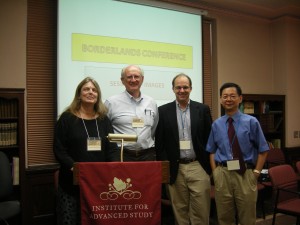 Ann Waltner, Ted Farmer, Jiang Yonglin: Mentors, Friends, Colleagues
Ann Waltner, Ted Farmer, Jiang Yonglin: Mentors, Friends, Colleagues
 One of many sports arenas at Minnesota, the TCF Bank Stadium. Seats 50,000, but expandable to 80,000.
One of many sports arenas at Minnesota, the TCF Bank Stadium. Seats 50,000, but expandable to 80,000.
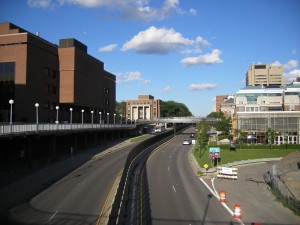 Who said an urban campus cannot be beautiful?
Who said an urban campus cannot be beautiful?
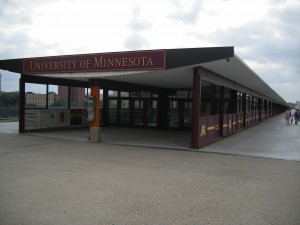 Interior of the walkway across the Mississippi River that connects both sides of the campus and keeps students from dying of exposure on the walk across. This interior has always been festooned with ads for student groups and activities.
Interior of the walkway across the Mississippi River that connects both sides of the campus and keeps students from dying of exposure on the walk across. This interior has always been festooned with ads for student groups and activities.
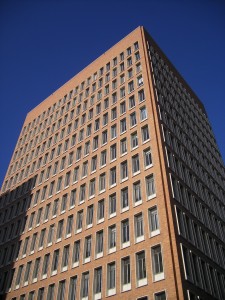 Social Sciences Tower, former home to the history department.
Social Sciences Tower, former home to the history department.
 Field trip to North West Company Fur Post site of the Minnesota State Historical Society. Pine City, MN.
Field trip to North West Company Fur Post site of the Minnesota State Historical Society. Pine City, MN.
Last July, 2010, in Tokyo for research at the archives of the former Ministry of Posts and Telecommunications, now called “Tei-park,” National Diet Library, and the used book stores of Jinbocho to hunt for postcards from imperial Japan. It was a very productive two weeks. And a great time to catch up with friends and colleagues.
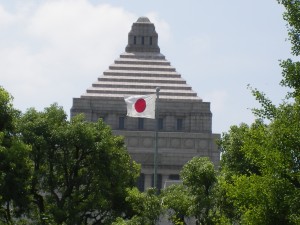 Japanese Parliament (aka Diet)
Japanese Parliament (aka Diet)
Best part of Parliament, at least for me.
A functional building, that Diet Library.
An interesting way to say good-bye to PM Aso.
View from Hejiribashi, between Ochanomizu station and my hotel room nearby.
Typical Jinbocho scene. Old Book Town.
Taking the train south to visit and old friend near Kamakura
Zushi beach near Kamakura
Standing bar/restaurant near Nakano Station, Tokyo
Nakano Station, Tokyo shopping and entertainment, early evening

Summer Research in Taipei.
On June 29th, I arrived in sunny Taipei and began work at Academia Sinica, a famous research institute on the far west end of Taipei in a district called Nankang (southern Harbor). A new subway stop has been added to the Bannan line called “Nankang” but it is still a good 30 minute hike to Sinica, if you can walk quickly.
The above picture is the guest center, which over the years has become slightly posh, though it has still retained most of its charm, like all-night ping pong in the basement, a cash-only (Taiwan Dollars) payment system, and a communal cafeteria whose staff lets you know who is boss. The best thing about the center is that its internet connection provides access to many of the Sinica on-line databases, in case you have time between rounds of ping pong at night.
Pictured below is the new combined Social Science and Humanities library. I did much of my work this summer in the Institute for Taiwan History’s digital archive preparatory room and this library.
One of my current interests is the production and dissemination of colonial postcards. At this institute, an image collection of some 4700 items, mostly picture postcards, is housed above the offices of the ITH. For a number of reasons, these are not accessible on line, though they have been digitized and put on a pretty good website. Luckily, I was allowed, by the grace of friends in high places, to study albums of copies of the cards. The most interesting cards in this collection, from my point of view, are the aerial views of Taiwan cities and the military campaigns against Indigenous Peoples. The former were illegal to publish, and were probably very quickly confiscated by the Japanese police. The latter are of interest because such cards ceased production by 1920, for reasons I am still exploring in my research.
 An exhibit from 2008
An exhibit from 2008

 An interesting postcard from research perspective
An interesting postcard from research perspectiveI hope that one day this digital archive will be open, or that at least researchers might be extended the usual options of photocopying, to further research into communications history, publishing, and design, not to mention colonialism.
In contrast to the secretive atmosphere surrounding the postcards, the vast library shared by the various institutes is open-stack and visitor-friendly. Large work spaces, internet access at each table, efficient copy rooms, and a good collection of periodicals, books, and assorted maps. The Social Science Humanities Library at Sinica has the most beautiful interior of any library I’ve had the pleasure to use.
 Keeping it real. For some reason, these tire gardens capture the flavor of the sidewalk that parallels “Research Road” connecting Academic Sinica to the MRT (subway station).
Keeping it real. For some reason, these tire gardens capture the flavor of the sidewalk that parallels “Research Road” connecting Academic Sinica to the MRT (subway station).
Next Stop. The National Central Library,
 No.20, Zhongshan S. Rd., Zhongzheng District
No.20, Zhongshan S. Rd., Zhongzheng District
This library is across the street from the Chiang Kai-shek Memorial Square (in Liberty Square).
The National Central Library boasts the largest collection of colonial Taiwan postcards that I know of. Like the Sinica ITH collection, access is restricted, photocopies verboten, and cameras not allowed. However, the actual cards can be viewed, along with the backs of the cards. Moreover, the Library’s website for the cards is public access, although the resolution of the images is too low to read captions. On the other hand, the meta-data is provided. All in all, curiously restrictive, but a step up from Sinica in terms of access.
The library also houses dissertations written at Taiwan universities and anything that has been published in or about Taiwan. The staff is exceedingly helpful. The security, admissions, and book retrieval systems are similar to the National Diet Library in Tokyo, but you can copy your own material in a copy room here, which can be a big advantage for smaller jobs or researchers on the go.
 Shade trees along the walk from MRT (subway) stop to the Library.
Shade trees along the walk from MRT (subway) stop to the Library.Next stop: Library of the former Government-General of Taiwan, aka the National Taiwan Library.
 No.85 Zhong-an St., Zhonghe City, Taipei County 235
No.85 Zhong-an St., Zhonghe City, Taipei County 235
The first floor of this library is very much a public space. Users of all ages come to watch movies, television shows, read magazines and visit the exhibits for children. The sixth floor, however, is a somber, state-of-the-art research center. Here, the staff all speak Japanese (hooray!) and there are no time-limits for use of the computers. The old library of the Taiwan Government General (Japanese colonial government, 1895-1945) is housed here (but not the documents: those are still in Nantou). While here I researched railway travel guides, photo albums, and the writings of early-twentieth century colonial officials. Most of the old materials exist as high-quality photo-copied, bound volumes or on microfilm.
 A typical Taiwanese sidewalk, sheltered from the blazing sun and the heavy down pours.
A typical Taiwanese sidewalk, sheltered from the blazing sun and the heavy down pours.
 A name to attract the archive rats
A name to attract the archive rats
 My home away from home during my stay in Taipei
My home away from home during my stay in Taipei
 Taipei 101 Tower in Xinyi district
Taipei 101 Tower in Xinyi district
 For small town resident like myself, these colorful bright lights of Xinyi require no justification. Lovely!
For small town resident like myself, these colorful bright lights of Xinyi require no justification. Lovely!
 Fellow out-of-towners taking photographs of Taipei’s squeaky-clean, punctual and reasonably priced subway system. Don’t even think about eating or drinking on these trains–you will get nailed (and fined, or at least scolded)
Fellow out-of-towners taking photographs of Taipei’s squeaky-clean, punctual and reasonably priced subway system. Don’t even think about eating or drinking on these trains–you will get nailed (and fined, or at least scolded)
 The Taiwan Store, near Taiwan National University. My favorite one-stop shop for the latest books about Taiwan (and postcards or assorted trinkets).
The Taiwan Store, near Taiwan National University. My favorite one-stop shop for the latest books about Taiwan (and postcards or assorted trinkets).
June 4th, 2010. Attended wonderful conference in Santa Barbara, CA, “2010 International Conference on Taiwan Studies. Taiwan Under Japanese Rule: Cultural Translation and Modernity.” Great panels and good fun drinking wine with friends new and old. Here’s my abstract and title:
The “Modern Marco Polo” Visits a Colonial Police State: Harrison Forman and Government Public Relations in Japanese Ruled Taiwan
On April 1, 1938, the photo journalist and travelogue writer Harrison Forman began a short tour of Taiwan. Only a few photographs from Forman’s excursion were published, as part of his 1940 Horizon Hunter: The Adventures of a Modern Marco Polo. Recently, however, over sixty additional photo negatives from this 1938 visit have been made available to researchers. Like the published photos, a great majority of Forman’s unpublished photographs were of Taiwan Indigenous Peoples. By 1938, wrote Forman, Taiwan had become a police state ruled by suspicion, secrecy, and fear. Nonetheless, the intrusive colonial state encouraged the production and dissemination of photographs of a certain type. This paper analyzes Forman’s unpublished travel notes and photographs, along with those of contemporary Western visitors to Taiwan, to ask why the Indigenous Territories, which had symbolized Japan’s shortcomings as a colonizer from the 1900s through the 1920s, had become the Government General’s preferred window upon the colony in the late 1930s.
I visited the Brookfield Zoo two days ago with my daughter and mother, just outside of Chicago. The rampant commercialism did not surprise me, I suppose without corporate buy-ins and sponsorship, the zoo could not maintain itself. But there were two very pleasant surprises: 1) the incorporation of Native American nomenclature and local knowledge into exhibits of North American animals:
and 2) the Mbuti-centered Rain Forest area.